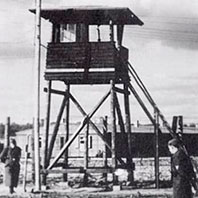|
The real Great Escape didn't feature Steve McQueen racing through
the Third Reich on a motorcycle like in the 1963 movie, but the big
breakout was still thrilling in every way. This program sheds new
light on the audacious escape of 76 Allied airmen from a Nazi POW
camp during World War II.
Sixty years after the event, NOVA follows a team of archeologists as
they search the site of Stalag Luft III for new evidence of the
clandestine operation, which involved 600 prisoners digging three
highly sophisticated tunnels, code-named Tom, Dick, and Harry. Each
tunnel was made with railways, electric lights, and underground air
pumps—all under the noses of German guards.
The detainees were planning to spring 200 men via Harry on the
moonless night of March 24, 1944. Unfortunately, a guard spotted the
77th man as he exited the tunnel beyond the perimeter fence, but 76
managed to get away, fanning out in all directions and forcing the
German army to commit tens of thousands of troops to an intensive
manhunt.
In the ensuing search through the camp to shut down all tunnels, the
guards never found Dick. But archeologists did, and NOVA films them
uncovering the cleverly concealed entrance, hidden at the bottom of
a washroom sump behind a concrete trapdoor that is still in place.
"Yes, I remember going down there about 60 years ago," reminisces
Jimmy James, a former RAF pilot who is one of several Great Escape
veterans to visit the excavation.
Incredibly, the tunnels were 30 feet deep—the height of a
three-story house—a measure taken to evade German listening
devices planted in the ground to detect tunneling activity. Another
challenge was the nearly pure sand through which tunnelers had to
dig; the airmen used wooden supports to keep the passages from
collapsing. Wood was in short supply at the camp and had to be
scrounged from bed slats and by cannibalizing the barracks. "Those
poor barracks: I wondered why they didn't fall down, because all the
bracing in the attics was practically taken out," recalls Charles
Huppert, a U.S. airman from Indiana.
Getting rid of sand also presented a problem, which was solved by
"penguins"—prisoners equipped with special trouser bags filled
with sand that could be discreetly scattered as the men waddled
around the camp. Tunnelers were equally creative in utilizing empty
milk cans to construct tools and ductwork for the ventilation
system. (For more on the tunnel, see
A Prisoner's Sketchbook
and
Inside Tunnel "Harry".)
To prepare for life on the lam, teams made insignias for escape
clothes and forged elaborate identity papers, evidence of which
turns up in the excavation of tunnel Dick. Future escapees were also
organized into small groups, each headed by a fluent speaker of
German.
Although Stalag Luft III was located in eastern Germany, in what is
now Poland, hundreds of miles from friendly territory, three men
managed to cross most of Europe and make it to freedom (see
The Three That Got Away). As for the 73 who were recaptured, 23 were returned to German
camps, and tragically, 50 were summarily shot in violation of the
Geneva Convention as Hitler's revenge against those who dared to
break out of his "escape proof" prison.


|


|
The Nazi builders of the Stalag Luft III prison camp
thought they had made it escape-proof, but they were
wrong.

|
|
|

